
In the high-temperature field of modern industry, fused cast AZS blocks, as a crucial refractory material, shoulder the heavy responsibility of ensuring the stable operation of all kinds of high-temperature equipment, especially in the use of glass furnaces. With their excellent high-temperature and corrosion resistance, fused cast AZS blocks have become an indispensable key material.
The quality of fused cast AZS block is directly related to the efficiency, cost, and even safety of industrial production. High-quality fused cast AZS blocks can withstand extremely high temperatures for a long time, effectively prevent high-temperature melt, slag, and other erosion of equipment lining, greatly reduce the frequency of equipment maintenance, reduce production costs, and ensure the continuity and stability of the production process; On the contrary, poor quality fused cast AZS blocks may spalling, cracking and other problems in a short period, resulting in equipment damage, production disruption, and huge economic losses.
In the whole production chain of fused cast AZS block, raw material selection and quality sublimation are the most critical two links. Raw materials as the foundation stone of the fused cast AZS block, its quality directly determines the basic performance of the finished product; The quality sublimation stage is through a series of fine and complex process to fully tap the potential of raw materials, remove impurities, optimize crystal structure, so that the performance of fused cast AZS blocks to achieve a qualitative leap to meet the increasingly demanding needs of industrial production. In-depth exploration of these two key links is of great significance for mastering the core technology of fused cast AZS block production and promoting industrial development.
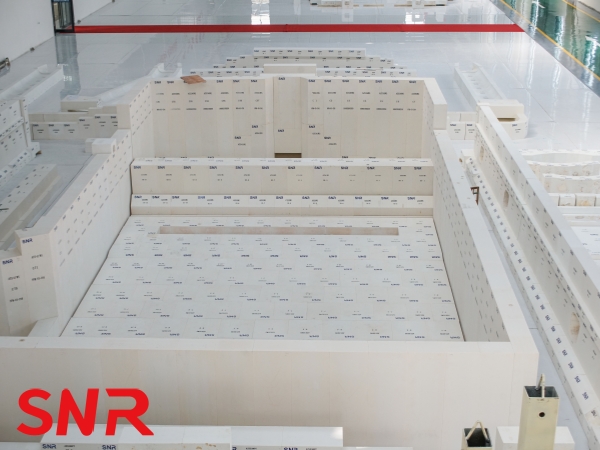
The core raw materials of fused cast AZS blocks mainly include aluminum oxide powder, zircon sand, etc., which are like building the cornerstone of the fused cast AZS block building and play a decisive role in the performance of the block body.
Aluminum oxide powder, as one of the key components of fused cast AZS blocks, has a very high melting point, up to 2050℃, which allows fused cast AZS blocks to maintain structural stability in the face of high-temperature environments. Alumina can form a corundum phase at high temperatures. The crystal structure of the corundum phase is tight, and the bonding force between atoms is strong, which gives the fused cast AZS block excellent high-temperature resistance and effectively prevents the erosion of the block body by high temperature. Moreover, the hardness of alumina is quite high, so the surface of the fused cast AZS block is not easy to be damaged when it is subjected to mechanical shock and friction, and it can maintain a good state of use.
Zircon sand, the main component of zirconia (ZrO2) content is usually about 65%, and silica (SiO2) content is about 34%. Zirconia has unique phase transition characteristics, in a certain temperature range occur tetragonal phase to monoclinic phase transition, this transition is accompanied by volume expansion, which can bridge the small cracks inside the block, enhance the thermal shock resistance of the fused cast AZS block, so that it is not easy to crack under the condition of acute cooling and acute heat. At the same time, the silica in zircon sand reacts with other raw materials to form a glass phase, which is filled between the crystal particles, plays the role of bonding and strengthening, and improves the overall strength of the block body.
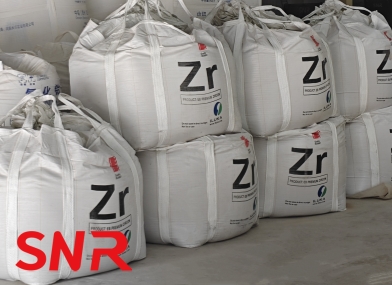
Taking the fused cast AZS33 block as an example, its alumina content is about 50%-55%, and the zirconia content introduced by zircon sand is about 33%. In the melting zone of a glass furnace, this ratio of fused cast AZS block can withstand the high temperature of glass liquid of more than 1600℃ for a long time, ensure the stability of the furnace lining, greatly extend the service life of the furnace, and reduce the high cost and time loss caused by frequent maintenance and replacement of the lining.
The high-purity raw material is the key to ensuring the excellent performance of fused cast AZS block. The higher the purity, the less impurity content, and the more fully the inherent properties of the raw material can be played. For example, the fused cast AZS block made of high-purity aluminum oxide powder (Al2O3 content≥99%) has stronger stability at high temperatures and increases its corrosion resistance by about 20% to effectively resist chemical erosion caused by slag and metal melt. High purity zirconia sand (ZrO2 content≥65%, impurity Fe2O3 < 0.1%) prepared by the block, white and pure, excellent thermal shock stability, in frequent temperature fluctuations, such as the metallurgical industry intermittent melting furnace, to maintain a longer service cycle, reduce the risk of block damage caused by the production. Ensure the continuity and efficiency of the production process.
The impurities in the raw material are called "destructive molecules" of the quality of the fused cast AZS block, even if they exist in trace amounts, they may cause a series of chain reactions and seriously damage the performance of the block.
Impurity elements such as iron (Fe), titanium (Ti), calcium (Ca), etc., will produce complex chemical reactions in the firing process of fused cast AZS blocks. Taking iron as an example, when the iron content in the raw material is too high, iron reacts with oxygen to form iron oxide (Fe2O3) at high temperatures. The melting point of iron oxide is relatively low (about 1565℃). When the fused cast AZS block reaches the normal service temperature (such as 1600℃ -1800 ℃), the iron oxide will melt first, destroying the original dense crystal structure of the block and forming a liquid phase channel. It makes it easier for external erosive media (such as high-temperature melt, slag, etc.) to penetrate the interior of the block and aggravate the degree of erosion. At the same time, the iron element may also cause the color change of the block body, the color of the fused cast AZS block with a high iron content is darker, the appearance quality is greatly reduced, and the application scenario with some color requirements (such as high-grade glass furnace) can not meet the use standards.
Titanium is also easy to form compounds such as titanates at high temperatures, and the coefficient of thermal expansion of these compounds is very different from the main composition of the fused cast AZS block. In the process of temperature change, internal stress will be generated due to the inconsistent degree of thermal expansion and contraction. When the accumulation of internal stress exceeds the withstand limit of the block, cracks will be caused, which seriously reduces the mechanical strength and thermal shock resistance of the fused cast AZS block. Shorten its service life.
To minimize the harm of impurities, impurity removal methods such as screening and iron removal are essential. In the early stage of raw materials in the factory, through the vibrating screen, air sieve, and other equipment for fine screening, according to the particle size, and shape differences, to remove the sediment, stone, and other large particle impurities mixed in raw materials, to ensure that the raw material particle size is uniform, laying a good foundation for subsequent processing. The iron removal link usually adopts electromagnetic iron remover, using the principle of electromagnetic induction, when the raw material passes through the strong magnetic field area, the iron-containing impurities are magnetized and adsorbed on the magnetic pole surface of the iron remover, to achieve the separation of iron impurities and raw materials. For some high-demand production processes, multi-level iron removal is also used, and iron removal devices are set up at multiple stages such as raw material crushing, mixing, and transportation to minimize iron content, ensure raw material purity, and ensure the high quality of fused cast AZS blocks.
The additive is like a magical "catalyst" in the production of fused cast AZS blocks, although the amount is not much, it can significantly improve the performance of the block and meet the diversified industrial needs.
►Take Na2O (sodium oxide) for example, which is a commonly used flux. In the firing process of fused cast AZS blocks, Na2O can reduce the melting point of raw materials, accelerate the melting process of raw materials, so that the components are fully mixed evenly, and promote the formation and growth of crystals. The appropriate amount of Na2O can reduce the sintering temperature of the fused cast AZS block by about 100℃ -150 ℃, which not only reduces energy consumption, reduces production costs, but also optimizes the internal structure of the block, makes the crystal development more complete, and improves the density and strength of the block. However, the Na2O content is not the higher the better, if excessive addition, will lead to too much glass phase content, glass phase at high-temperature viscosity reduction, fluidity increase, making the block prone to deformation when used at high temperature, erosion, and other problems, seriously affecting the service life and stability of fused cast AZS blocks.
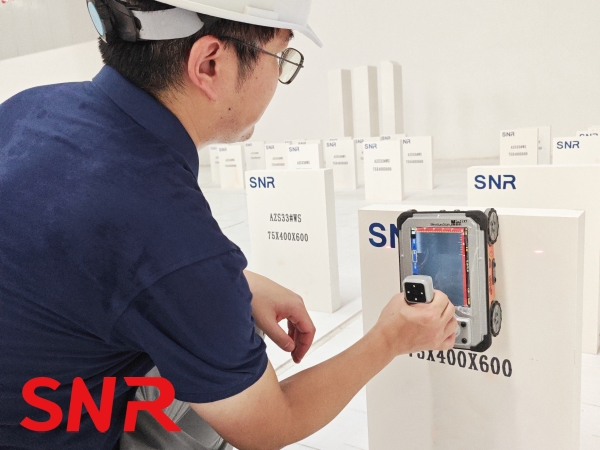
Different types of fused cast AZS blocks have different types and ratios of additives according to their application scenarios and performance requirements. For the fused cast AZS block used in the reheater of the glass furnace, to improve its alkali attack resistance, an appropriate amount of zirconite fine powder and rare earth oxide are added. Rare earth oxide can combine with alkali metal ions, inhibit alkali attack reactions, and extend the service life of the fused cast AZS block. The reasonable additive formula is optimized through a large number of experiments and actual production experience, and the accurate ratio control is the key link to ensure the performance of the fuse block meets the standard, and any small deviation may cause performance fluctuations and affect product quality.
As the first key process of the production of used cast AZS block, the precision of the batching is like the scale on the precision instrument, which is directly related to the quality of the product.
Precise dosing has a remarkable effect on the stability of fused cast AZS block products. By strictly controlling the proportion of ingredients, the chemical composition of each batch of blocks is highly consistent, which ensures the stability of the physical and chemical properties of blocks under a high temperature environment. In the practical application of a glass furnace, the fused cast AZS block produced by precise batching can resist the erosion of glass liquid stably for a long time, maintain the structural integrity of the furnace lining, reduce the furnace failure caused by the fluctuations in the performance of the block, greatly improve the continuity of glass production and the quality of the finished product, and bring considerable economic benefits to the enterprise.
Electric arc furnace melting is the core link of the production of fused cast AZS blocks, like a "gorgeous transformation" on the high-temperature stage, converting evenly mixed raw materials into high-quality electric melting liquid.
Melting temperature and time are the two key factors that affect the quality of fused cast AZS block.
►Taking the fused cast AZS33 block as an example, when the melting temperature is accurately controlled between 2200 ° C and 2300 ° C, and the melting time is maintained at 4-6 hours, the ingredients such as alumina and zircon sand in the raw material can be fully melted and reacted to form a uniform and dense liquid phase. In this process, the crystal growth is finely regulated, and the key crystal structures such as the corundum phase and zirconium crinoline are perfectly developed, giving the fused cast AZS block excellent high-temperature resistance and corrosion resistance. If the melting temperature is too low or the time is too short, the melting of the raw material is incomplete, which will lead to the occurrence of unmelted particles inside the block body, seriously affecting the structure density and reducing the strength and corrosion resistance. On the contrary, if the temperature is too high or the time is too long, although it can ensure that the raw material is fully melted, it may cause excessive crystal growth, make the crystal structure coarse, reduce the toughness of the block, and increase the risk of thermal shock cracking.
The casting process is a key step in the transformation of fused cast AZS blocks from liquid to solid. During this process, factors such as mold design and casting speed are intertwined and jointly affect the quality and performance of the blocks.
Mold design can be called the "blueprint" of casting molding, which directly determines the external accuracy and internal structure of the fused cast AZS block. For some complex shapes of fused cast AZS blocks, such as special-shaped blocks used in the bubbling part of the glass furnace, the internal cavity structure of the mold needs to be carefully designed according to the function of the block and the characteristics of the thermal stress distribution. Reasonable mold design can ensure that the material liquid forms a uniform temperature gradient during solidification, guide the orderly growth of crystals, avoid local stress concentration, and reduce the risk of cracks. For example, the split mold structure can effectively reduce the mechanical stress on the block body and protect the integrity of the block body during demoulding; Setting a specific heat dissipation structure on the inner wall of the mold can accelerate local heat dissipation, regulate the direction of crystal growth, and improve the density and strength of the key parts of the block body.
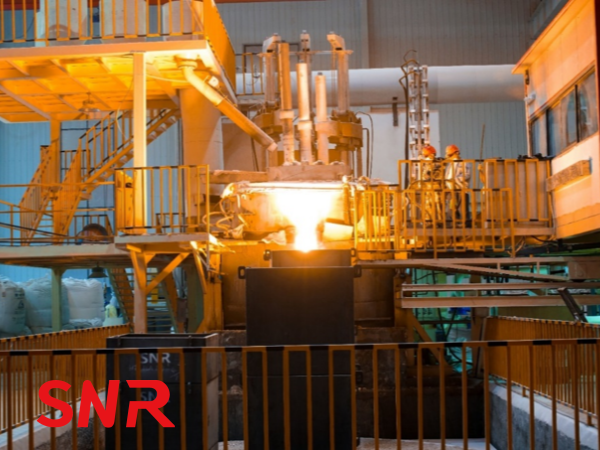
The casting speed is another key "rhythm master" that affects the quality of the block. If the casting speed is too fast, the electro-melt rushes into the mold like a surging tide, which is easy to contain a lot of air, resulting in bubble defects inside the block body. These bubbles may become stress concentration points in the process of high-temperature use, leading to crack expansion; At the same time, too fast casting speed may also lead to uneven material liquid flow, resulting in the segregation of components in different parts of the block body, affecting the overall performance consistency. On the contrary, the casting speed is too slow, the electro melt cools too fast in the mold, the viscosity increases, the fluidity becomes poor, and problems such as incomplete casting and cold insulation will occur, which also seriously damages the quality of the block.
To solve the problems such as bubbles and cracks that may occur in the casting process, the company has taken a series of innovative measures. In terms of degassing, the vacuum degassing treatment is carried out on the electro-melt before casting, and the gas solubility in the liquid is reduced by using the vacuum environment, which promotes the escape of bubbles and significantly reduces the porosity defects inside the block body. At the same time, the exhaust channel is added to the mold design to ensure that the residual gas can be smoothly discharged during the casting process. According to the size and shape of the block, the matching relationship between casting speed and cooling rate was calculated accurately. The process methods such as fractional casting and slow cooling were adopted to reduce the thermal stress. In addition, the appropriate amount of additives with toughening effects, such as rare earth oxides, are added to the raw material formula, which can improve the toughness of the block body by improving the binding force between the crystals, effectively inhibiting the generation of cracks, and ensure the quality of the fused cast AZS block.
Annealing is a crucial process in the production of fused cast AZS blocks. Its core purpose is to eliminate the internal stress accumulated inside the block body due to rapid cooling and heating processes.
After the casting of the fused cast AZS block, due to the rapid cooling from the high-temperature liquid to the solid state, the cooling rate of each part of the block is difficult to be completely consistent, which is like burying a "stress bomb" inside the block. When the accumulation of internal stress exceeds the strength limit of the block material itself, cracks will breed and seriously damage the quality and performance of the block. Annealing treatment is to precisely control the temperature and time, so that in the block body in a specific temperature field environment, the internal atoms have enough energy to slowly migrate, rearrange, so that the lattice distortion is repaired, and then eliminate the internal stress, as for the block to disperse the internal "uneasy factors", so that its structure becomes stable.
►Taking fused cast AZS blocks as an example, in actual production, the thermal annealing method is one of the more common annealing methods. Usually, the fused cast AZS block is placed in a specially designed annealing furnace or incubator together with the mold. The annealing temperature is generally set in the elastic-plastic temperature range of the block material, such as between 1100 ° C and 1250 ° C, which can make the block material in an ideal state that has a certain plasticity and will not be overly softened, to facilitate the release of internal stress. The holding time is finely adjusted according to the size, thickness, and specific composition of the block body, and the holding time is about 24-36 hours for standard fused cast AZS blocks with a thickness of 200-300mm. In the heat preservation process, the temperature fluctuation should be strictly controlled within a very small range, generally requiring no more than ±10 ° C, to ensure that the block body is evenly heated and the internal stress can be smoothly eliminated.
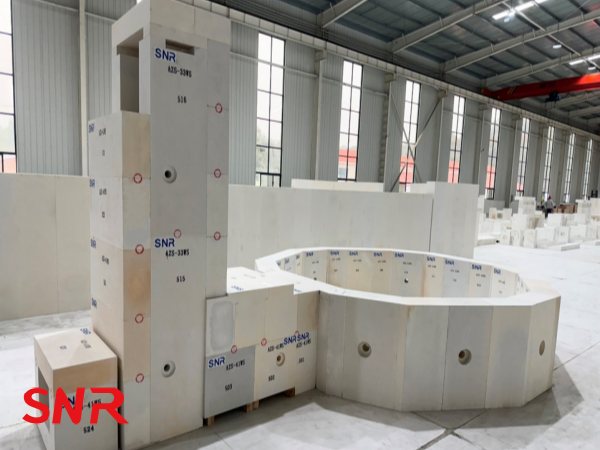
External heating annealing method is also a feasible way, by arranging heating elements around the block body, continuous heat from the outside, supplementing the energy lost by heat dissipation of the block body, and maintaining a specific annealing temperature. This method is more suitable for some complex shapes and large sizes of special-shaped fused cast AZS blocks, which can ensure that heat is accurately transferred to all parts of the block body and avoid local stress residue.
The fine processing link is like a master sculptor who performs the final carving on the fused cast AZS block, giving it excellent appearance quality and precise dimensional accuracy, so that it can perfectly adapt to the strict installation and use requirements of various high-temperature industrial equipment.
►At the beginning of fine processing, the cutting process plays a decisive role in controlling the dimensional accuracy of the fused cast AZS block. In modern industrial production, more high-precision diamond cutting equipment is used, and its cutting blade hardness is extremely high, which can achieve accurate segmentation of fused cast AZS blocks with minimal cutting loss. In the cutting process, the CNC system precisely controls the cutting path to ensure that the length, width, thickness, and other dimensional tolerances of the block body are controlled within a very small range, generally up to ±0.5mm. For some high-end application scenarios, such as the high-temperature furnace lining block in the field of semiconductor manufacturing, the dimensional tolerances can be accurate to ±0.1mm. It meets the strict requirements of super precision equipment for the consistency of block size.
►The grinding process is like doing a "deep SPA" on the surface of the fused cast AZS block, aiming to further improve the smoothness and finish of the block surface. The use of professional grinding machinery, with different grit sandpaper or grinding wheels, from coarse grinding to fine grinding step by step. The coarse grinding stage can quickly remove the small defects and scratches left on the surface after cutting so that the surface roughness (Ra value) from the initial tens of microns is quickly reduced to a few microns; The finishing process further optimizes the Ra value to between 0.8-1.6 microns, laying a good foundation for subsequent polishing processes. For example, in the application of bubble blocks in glass furnaces, the surface of the finely ground fused cast AZS block can effectively reduce the flow resistance of the glass liquid, avoid the adhesion and accumulation of bubbles on the surface of the block, improve the convection efficiency of the glass liquid, and improve the quality of glass production.
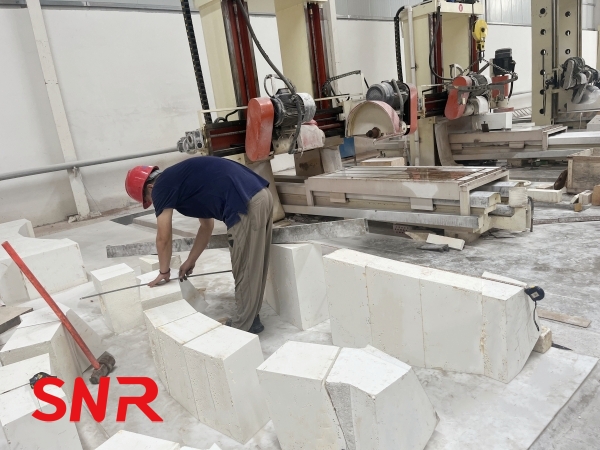
►The polishing process is a fine processing of the "finishing pen" so that the surface of the fused cast AZS block achieves mirror-like smoothness. The use of chemical mechanical polishing (CMP) and other advanced technology, combined with special polishing fluid, in the polishing process, the small abrasive particles in the polishing fluid and the surface of the block soft chemical reaction, at the same time with the mechanical grinding, remove the surface of the very fine uneven, so that the surface roughness Ra value is finally reduced to 0.1-0.4 microns. The effect is as bright as a mirror. This not only improves the beauty of the fused cast AZS block but more importantly, in some applications that require very high surface purity, such as electronic grade glass manufacturing furnaces, it can effectively prevent impurities from falling off the surface of the block and containing the glass liquid to ensure product quality.
With the increasing awareness of environmental protection and increasingly precious resources, the recycling and utilizing of waste-fused cast AZS blocks has gradually become the key path to the sustainable development of the fused cast AZS block industry.
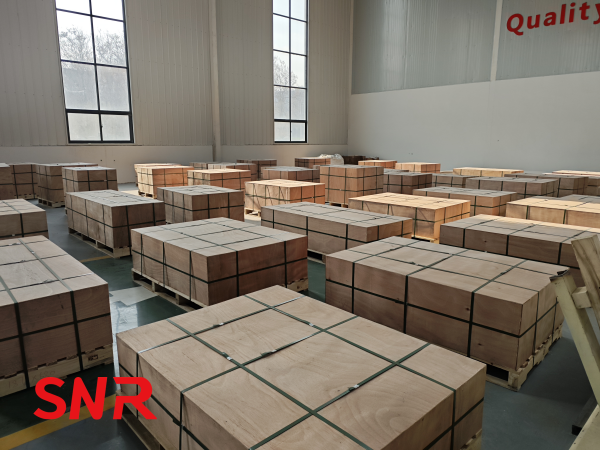
.png)
At present, the recycling and utilization of waste fused cast AZS blocks in some advanced enterprises has begun to show results. These enterprises have built up a relatively complete recycling process: first, the use of professional crushing equipment to crush waste fused cast AZS blocks into uniform particles; Then, with the help of the fine screening device, according to the size of the particle classification screening, to meet the different reuse needs; Subsequently, through magnetic separation, flotation and other technical means to remove the metal impurities, impurities minerals and attached slag in the waste electric melting blocks, the maximum extent of purification of recycled materials.
Raw material selection and key link control are the core elements of quality sublimation of fused cast AZS block. From the initial raw material screening, strictly control the quality of core raw materials, strictly control impurities, and scientific use of additives, to lay a solid foundation for the fused cast AZS block; To the precise batching in production, high temperature melting, casting molding, and then to the later annealing, fine processing, each step is closely linked, determining the final performance of the fused cast AZS block. Any slight deviation or negligence may make the fused cast AZS block fail under high temperatures, chemical erosion, and other harsh conditions, affecting the stability and efficiency of industrial production.

Henan SNR Refractory Co., Ltd(SNR) specializes in producing high-quality fused cast AZS blocks, strictly controlling every step from raw materials to finished products.If you have any needs, please contact us.
 Web:www.snrefractory.com
Web:www.snrefractory.com
Email:moon@snrefractory.com